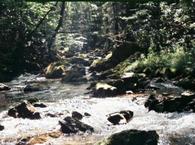I had never been keen on fishing the tailwater streams until I heard a presentation from Chris Scalley from River Through Atlanta. Chris guides on the Chattahoochee River where the flow of water down the river comes from the Buford Dam. Some popular tailwater rivers in North Carolina include the Nantahala, the Watuga and the South Holston. 
First, what do we mean by tailwater? Tailwater is the water below a dam or other hydroelectric facility that is subject to changes in flow. The water is released at various rates and scheduled times in accordance with policies established by the US Government, but controlled by the local hydroelectric authorities. When there is a good deal of rain, the water impoundment fills up and it is necessary to release at a higher rate in cubic feet per second and often more frequently or for longer periods.
This scheduled release of water causes the river to offer two very different types of water. When there is no release of water, the river will be low and produce excellent results when wading. When the water is being released, the best way to fish for trout will be in a boat, raft, or canoe. Of course fishing along the bank where accessible is always an option. When water is being released, it can be timed and you will know when it will reach your destination down stream because it travels at a predictable rate of miles per hour.
For example, to get to a point 2 miles down from the dam on the South Holston, it will take approximately 1.25 hours, so if the water is released starting at 9:00 AM, you can safely wade the stream until 10:00 AM. You should always pay careful attention to the release schedules and the release rates as the rapidly rising water levels can provide a real hazard to any angler. It is a good idea for any angler to wear a PFD when fishing tailwaters. Here are a couplle of release schedules. Nantahala River where the discharge is controlled by Duke Energy and the Watauga where the discharge information is published by the Tennessee Valley Authority.
Tailwaters have a constant temperature the year around and this is due to depth of the water in the impoundment. This fairly constant temperature allows the aquatic insects, bait fish, crustaceans etc, to flourish. Also many tailwaters will have a PH above 7.0 making them alkaline. Alkaline water will support huge hatches of caddis flies and midges providing the trout population with a stable source of food. This source of food allows the trout to grow very rapidly.
Usually, the trout found in tailwaters are larger, more active and provide a greater fight than the trout found in many creeks and streams. This is due to both the food supply and high dissolved oxygen level of the water. Learn much more about tailwaters and how to fish them by watching the DVD “Fly Fishing for Trout in Tailwaters” by James Marsh.`





